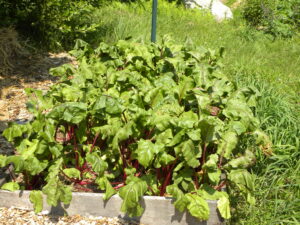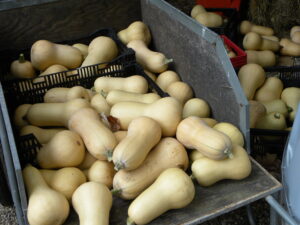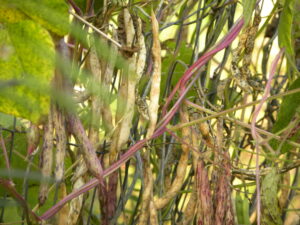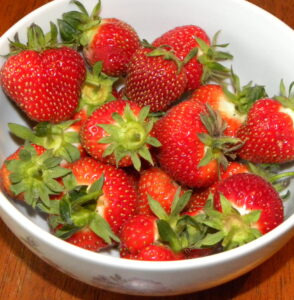In my last post I reported on our 2024 yield numbers. In this one I will consider what we learned during the season while growing all that food.
Taking this opportunity to review is an example of Permaculture Principle 4: apply self-regulation and accept feedback. It sounds simple, but is challenging for many of us.
The world is complex and determining cause and effect is difficult, sometimes impossible. Often people don’t have patience with not knowing and would rather jump to a wrong conclusion than allow for uncertainty.
There is also a lot of judgment associated with struggling, being wrong, and making mistakes.
Personally, I was raised to be a good girl, bring home As, do everything right. That turns out to be really limiting. If you don’t feel like you can fail, then you don’t try new things or take risks and you miss out on the thrill of learning. Despite my early training, my inquisitive mind drove me to keep exploring and I have become increasingly comfortable with the exciting and frustrating stages of learning. Teaching others was particularly helpful for me to build my tolerance for being a beginner.
As a society, we aren’t displaying much of an ability to thoughtfully grow and change. This is a serious problem at a time when we need to adapt or face serious consequences. There are critical mistakes we are repeating in how we behave but don’t seem to learn from them.
So, on a personal and cultural level, learning to welcome feedback and criticism is an important goal. It helps to intentionally build those abilities. This yearly review of our homestead is one way I do that.

Brussels Sprout Seedlings
Let me start early in the year…
Seed Starting Success
I have tried many different ways of starting seeds. As much as possible, I wait and plant the seeds outside, but that doesn’t work well for long-season crops here in the North. I started years ago in a window with no additional energy for grow lights. Those plants were spindly and never grew straight. I took the feedback and we made shelving and added lights. That worked a lot better, but the plants still weren’t as tall and straight as I wanted. Last year we researched and found that high quality LED grow lights had come down in price. We were able to phase out the florescent lights (which always made me nervous because of their mercury content), and switch to this stronger, more energy efficient type. The results were great!

Seedlings Growing Straight and Tall
Rodent Proofing Success

Carrots in the Very Raised Bed
Over the past decade, the vole population has steadily increased. We’ve successfully protected our fruit trees with wire mesh (1/8th inch screening) around the lower trunks, but our root crops have suffered. It is so disappointing to pull up a carrot, beet or parsnip only to find 90% of it eaten away. I tried rotating the root crops, but that didn’t fool them. A couple of years ago friends gave us a standing garden bed. It was totally vole proof and produced perfect carrots! But, it was hard to keep watered well enough. We experimented by building wooden raised beds with hardware cloth stapled on the bottom then placing them on the ground. We can see the tunnels going underneath, but so far they have not made it through the wire. One bed wasn’t very tall and voles climbed in from the top and chewed on the exposed beet shoulders. We extended the walls of that one higher for this coming season.

Beets in Raised Bed, Later Added Taller Sides

Potatoes in Barrels
We also used plastic barrels cut in half with holes drilled in the bottom, mostly for potatoes. Watering was again tricky. The water tended to just run down the sides of the barrel while the middle dried out but the water drained slowly so the bottom was waterlogged. We were able to manage that with careful hose positioning and creating some holes in the center of the bed, though, and did get a respectable harvest. Nothing like the early potato years with yields of 20 to 1, but better than the vole decimated years when we had 2 to 1 returns.
Brassica Pest Control
I am not really an expert on garden insect pests and diseases because I have a wait-and-see, live-and-let-live attitude for the most part that has served me well. If a new insect or mold appears and starts negatively affecting the plants, I try to wait two years before considering it a problem I need to react to. What I have found is that lots of creatures have boom and bust cycles. For instance, we might have a terrible squash borer year that takes out most of our squash plants, but the following year is then great for squash. Or, we have an outbreak of tomato hornworms. If I do nothing, then within a month the parasitic wasps have found them, eaten them, and I usually won’t see hornworms again for years. I have learned from this to remain calm, observe, and see if the larger ecological system works it out without my help.

Kale
Sometimes, though, that fails. Which brings me to the brassicas. I love this family of plants, especially collards, kale, and Brussels sprouts. We have always had some issues with worms eating them: Imported Cabbageworms, Cabbage Loopers and Diamondback Moth Caterpillars. Some years I have protected them with row cover to give them a good start before the bugs found them. I tried planting them far apart from each other, a plant here and there among others the worms didn’t like. I tried different varieties. I did some handpicking of the worms, but that is so tedious. All of this helped some, then I consoled myself with the knowledge that chewed on veggies are actually more nutritious. However, about 3 years ago, a new brassica pest appeared on the scene: cross-striped cabbageworm. Once they settled in, they started decimating plants, leaving just stems of the kale and collards and swarming the broccoli and Brussels sprouts. It was awful that year. I waited – and it was just as bad the next year. So, it was time to not just observe, but to interact and come up with a plan.

Brussels Sprouts with Row Cover Raised for Harvest
I will not use chemical controls, but a barrier preventing the moths from reaching the plants is an option. I hesitate embracing this method because row covers are made of plastics, eventually ending up in landfills. I’ve been willing to compromise on this, though. The other problem is that most row cover is hard to water through and not tall enough to cover our huge plants. We discovered a new kind of mesh covering which let more light and water through and came in larger sizes. We also built supports to drape it over so we had better access and it didn’t inhibit plant growth. We made two beds, one for greens, the other for Brussels sprouts. We didn’t properly secure the one over the kale and collards so the moths infiltrated and chewed them up. However, we successfully protected the row with the sprouts (and a few kale plants)… and it made a huge difference! The plants were beautiful and healthy and it was a treat to not have to deal with the worms hiding in there.

Perfect Brussels Sprouts!
Those were a few takeaways from 2024 from our homestead. What did you learn that you will bring into this year’s endeavors?

Brussels Sprouts Developing With Low Pest Pressure

















